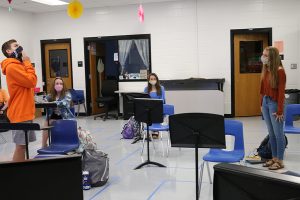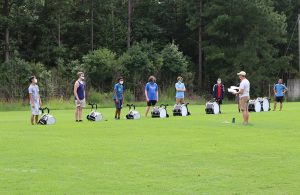The show must go on
Fine arts department making adjustments under new guidelines
Choral director Dr. John Odom instructs Chanticleer from a distance. All students are separated in 6-foot intervals and required to wear masks. Studies have shown that it is safe to sing for 30 minutes without the spread of aerosol in the air. Many students have switched to virtual further reducing the risk of contact, but fewer students and strict guidelines have forced many changes and adaptations in the performing arts.
COVID-19 has left the student body desperate for entertainment and creativity, but nothing has gone back to normal. Like other schools, Starr’s Mill is required to follow guidelines and procedures to protect student health and prevent COVID-19 cases from rising.

Fine arts are not excluded from these policies, and teachers have adjusted according to what’s best for their individual performance environments.
All sections of the fine arts department have seen a reduction of enrollment with students going virtual, while reorganizing classrooms to fit spacing guidelines mandated by the Board of Education. Students must have at least a 4-foot-by-4-foot space between their classmates, and wear a mask.
Drama teacher Savahna Silvas uses the spacing “boxes” to help students improve their performance skills from a distance. Classmates can perform “with” one another across the room, but without any direct contact. Another challenge is the masks, which take away the dramatic, passionate element of acting.
“Your whole face is extremely expressive,” Silvas said. “The eyes can tell a lot.”
The drama department prepares students to succeed in a live setting, with the ultimate goal of competing in shows. This year, however, Starr’s Mill will not participate in these competitions. Drama also does not know if the spring musical will be live, so dates and potential conflicts with other fine arts departments are a guessing game.
“Honestly, actors tend to feed off audience members, even if we tell them not to,” Silvas said. “I think it’s going to take away some of that magic of the live theater we love so much.”
Performing was the least of the choral department’s worries. Singing is performing and acting at the same time, but choral director John Odom started the year not even sure if singing was possible.
“The big question was: ‘Are we even going to be able to sing?’” Odom said.
Studies from the University of Colorado, the American Choral Directors Association, and National Association of Music Education state that students can safely sing 6 feet apart with masks for 30 minutes at a time. In turn, this has altered the classroom dynamic significantly in addition to there being fewer singers per class period.
Last spring, the choral department had a virtual musical. This year, all five high schools hope to combine their different choirs for a five-song mass performance. Individual students will record their part, then a professional production company will piece together all recordings. The final product will sound like a performance from a mass choir, without the risk of spreading aerosol to the students and audience.

Learning that aerosol contributes to the spread of COVID-19, assistant band director Bert Groover plans to have individual families make do-it-yourself bell covers and specialized masks. In class, these will be used along with the variety of spacing for the assortment of band instruments. Outside of the classroom, however, marching band will not be required to wear masks since they will be practicing in an open space. In addition, their practices will be less frequent than previous years.
Groover has added virtual elements to everyday band rehearsals, like the app Upbeat. Marching band and band students alike can record themselves simultaneously to create virtual quartets. This software may replace a concert if needed.
For this year, the winter concert will not be adjoined with the middle school, but live quartets may be held in different classrooms to form a “traveling” concert.
“The audience would go to them and move around the school to help containment,” Groover said.
Despite these new limitations being applied this year, Starr’s Mill is determined to give students the satisfaction of a performance and show the results of their hard work.
These new obstacles may propose a challenge, but the show must go on.


